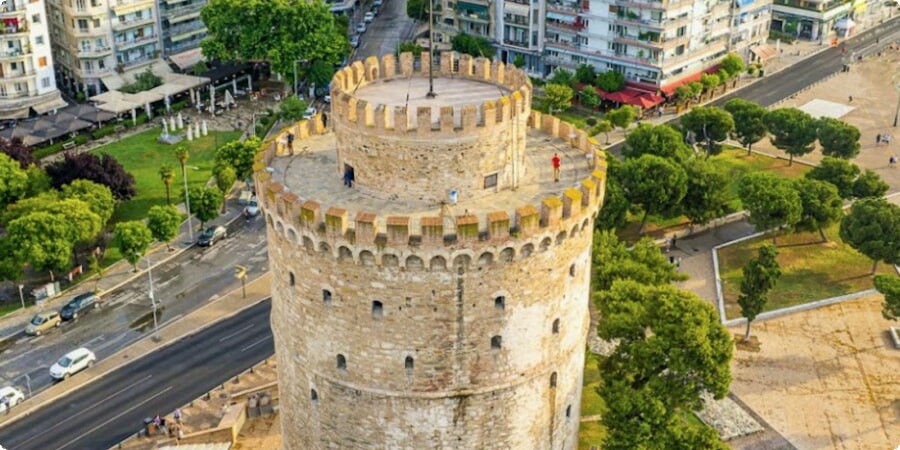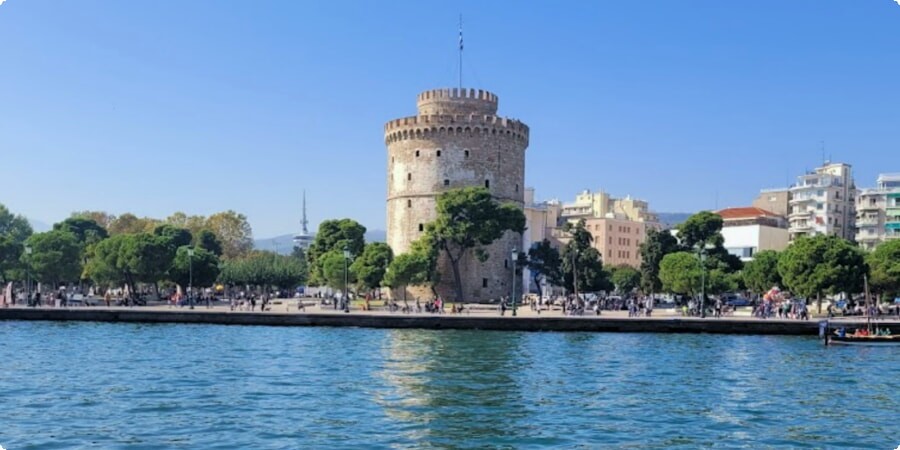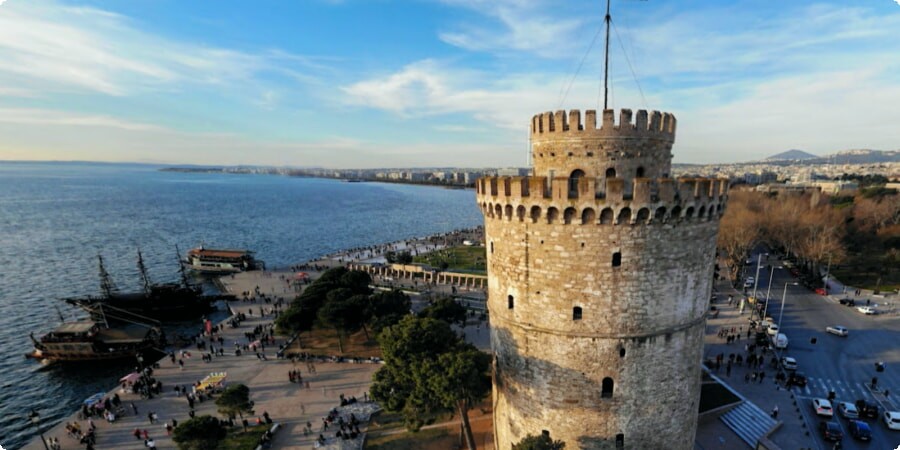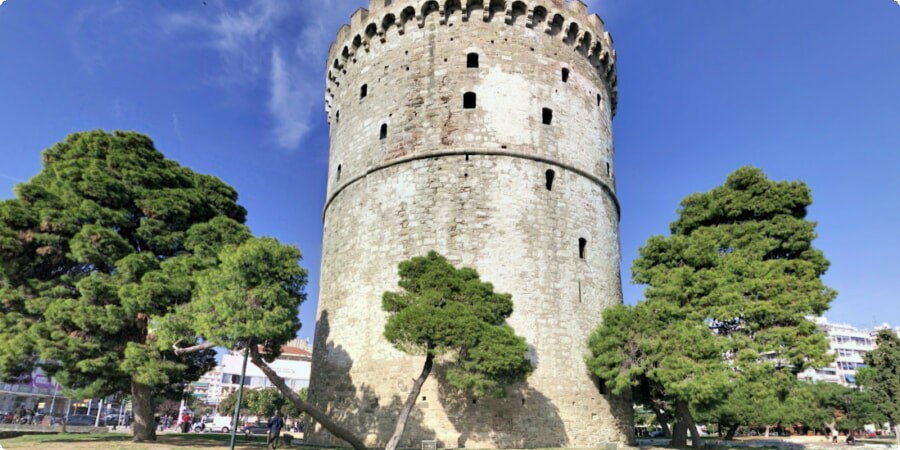The White Tower: Thessaloniki’s Iconic Landmark
Thessaloniki, Greece's vibrant second city, is a captivating blend of ancient history and modern culture. Among its many landmarks, none stand as prominently as the White Tower. This iconic structure is more than just a historical monument; it is a symbol of the city's resilience and a testament to its rich past. Nestled on the waterfront, the White Tower offers a unique glimpse into the layers of history that have shaped Thessaloniki over the centuries.
Historical Background
The story of the White Tower begins in the 15th century, during the reign of the Ottoman Empire. It was built as part of the city's fortifications, replacing an older Byzantine tower. The primary purpose of the White Tower was defensive; it was strategically positioned to protect the city's harbor and was integral to Thessaloniki's coastal defense system.
Over time, the tower's role evolved. In the 19th century, it gained notoriety as a prison and site of executions. The tower's grim reputation earned it the nickname "Tower of Blood." This dark chapter of its history ended in 1912, when Thessaloniki was liberated and became part of Greece. The tower was subsequently whitewashed to symbolize a new beginning, hence the name "White Tower" (Λευκός Πύργος). Today, it stands as a poignant reminder of the city's turbulent past.
For more details on its historical background, you can visit the Wikipedia page on the White Tower of Thessaloniki.
Architectural Features
The White Tower is a fine example of military architecture from the Ottoman period. It stands 34 meters tall and has a diameter of 70 meters at its base. The cylindrical structure is topped with a turret, providing a striking silhouette against the Thessaloniki skyline.
Inside, the tower is divided into six floors connected by a spiral staircase. Each level has narrow, arched windows that offer glimpses of the outside world, serving both as lookout points and as sources of light for the interior. The tower's walls are made of brick and stone, which have weathered the centuries remarkably well.
One of the most fascinating aspects of the White Tower is its dual function as a fortification and a residence. The lower levels were used for storage and as barracks, while the upper floors housed soldiers and officers. This blend of practicality and strategic design highlights the architectural ingenuity of the period.

For a detailed exploration of the tower's architecture, a visit to the tower itself is highly recommended. To make your trip more convenient, consider booking a car at Thessaloniki Airport through Lucky Car. This will give you the flexibility to explore the city and its surroundings at your own pace.
Exploring the White Tower and its surroundings offers a tangible connection to Thessaloniki's rich past. From its defensive origins to its transformation into a museum, the White Tower encapsulates the city's enduring spirit and historical significance. As you wander through its halls and climb its winding stairs, you'll be walking in the footsteps of the many who have passed through its doors over the centuries, each leaving their mark on this remarkable monument.
The Tower’s Transformation
The White Tower’s transformation from a grim prison to a vibrant museum is a testament to Thessaloniki's commitment to preserving and celebrating its history. Following the city's liberation in 1912, the tower underwent significant changes. Its infamous nickname, "Tower of Blood," was replaced by "White Tower" after it was whitewashed, symbolizing a new chapter in its storied past.
The real transformation began in the 20th century when the tower was repurposed as a museum. Extensive restoration work was carried out to preserve its structural integrity while making it accessible to the public. Today, the White Tower houses an interactive museum that showcases the city's rich history from ancient times to the present. Each floor of the tower presents different eras and aspects of Thessaloniki’s past, providing visitors with a comprehensive understanding of its historical significance.

The Museum Experience
Visiting the White Tower museum is like stepping into a time machine that takes you through the various epochs of Thessaloniki's history. The museum is divided into six floors, each dedicated to a different theme. As you ascend the spiral staircase, you’ll encounter exhibits that include artifacts, multimedia displays, and interactive installations.
On the first floor, the focus is on the ancient period, highlighting Thessaloniki's foundation and its significance in antiquity. The second floor covers the Byzantine era, showcasing the city’s role as a major center of the Byzantine Empire. The third floor delves into the Ottoman period, offering insights into daily life and the cultural influences that shaped the city during this time.
One of the highlights of the museum is the fourth floor, which is dedicated to the 20th century and includes the turbulent times of the Balkan Wars and World War II. The fifth floor presents modern Thessaloniki, emphasizing its cultural and economic development. The top floor provides a panoramic view of the city, making it a perfect spot for photography and reflection.
The White Tower in Popular Culture
The White Tower holds a special place in the hearts of Thessaloniki’s residents and has become an iconic symbol of the city. Its striking silhouette and historical significance have made it a popular subject in literature, films, and media.
In Greek literature, the White Tower is often mentioned as a symbol of Thessaloniki's resilience and historical depth. It has appeared in numerous novels and poems, reflecting the tower's deep connection to the city's identity. The tower's cinematic appeal is also evident, as it has been featured in various Greek films and documentaries, often used as a backdrop to stories set in Thessaloniki.
Beyond its appearances in literature and film, the White Tower is a focal point in many of the city's cultural events and festivals. It is not uncommon to see the tower illuminated during special occasions, serving as a beacon of Thessaloniki’s vibrant cultural scene. The tower's image is also widely used in promotional materials and souvenirs, further cementing its status as a symbol of the city.

For those inspired to explore the rich history and culture of Thessaloniki further, having the freedom to move around at your own pace is invaluable. Consider renting a car in Greece to make the most of your visit. You can book a car through Lucky Car to ensure you have the flexibility to discover all that Thessaloniki and its surroundings have to offer.
The White Tower stands not just as a monument, but as a living symbol of Thessaloniki's enduring spirit and historical richness. Whether you're wandering through its museum or simply admiring its presence along the waterfront, the tower offers a profound connection to the city's past and present.
Architectural Significance
The architectural design of the White Tower is a captivating blend of medieval and Ottoman styles, reflecting the historical periods it has witnessed. Standing 34 meters tall, the tower features a cylindrical structure made of limestone and brick. Its solid, imposing appearance is softened by the subtle elegance of its design.
The tower’s base consists of a robust circular wall, with six floors connected by a spiral staircase. Each floor has narrow, slit-like windows that were originally intended for defense purposes, allowing archers to shoot while remaining protected. These windows now provide visitors with glimpses of the surrounding city as they ascend.
The top of the tower features a crenellated parapet, typical of fortifications, which adds to its fortress-like appearance. This parapet was once an important defensive feature, but today it serves as an observation deck, offering panoramic views of Thessaloniki and the Thermaic Gulf.
The blend of functionality and aesthetics in the tower’s design showcases the architectural ingenuity of the time. Its preservation and continued use as a museum highlight the importance of maintaining historical structures for future generations to appreciate.
Planning Your Visit
A visit to the White Tower is a must for anyone traveling to Thessaloniki. The tower is conveniently located on the city’s waterfront promenade, making it easily accessible for tourists and locals alike. The surrounding area is also home to several other attractions, including the Archaeological Museum of Thessaloniki and the Macedonian Museum of Contemporary Art, both of which are worth exploring.
The White Tower is open to the public year-round, with extended hours during the summer months to accommodate the influx of visitors. Admission fees are modest, and discounts are available for students, seniors, and large groups. It’s advisable to check the official website for the latest information on opening hours and ticket prices.

For a seamless travel experience in Greece, consider renting a car to explore Thessaloniki and beyond at your own pace. You can book a car through Lucky Car to ensure you have the freedom to discover the rich history and beautiful landscapes of this remarkable region.
Nearby Attractions
Thessaloniki is a city rich in history and culture, and the White Tower is just one of many fascinating sites to explore. Within walking distance of the tower, visitors can find a plethora of other attractions that offer further insights into the city's storied past.
One such attraction is the Rotunda, an ancient Roman structure that has served various roles over the centuries, including a mausoleum, a church, and a mosque. Today, it stands as a testament to the city's diverse historical influences and is a UNESCO World Heritage site.
Another nearby site is the Church of Hagia Sophia, an impressive example of Byzantine architecture. This church, also a UNESCO World Heritage site, has a rich history dating back to the 8th century and features stunning mosaics and frescoes. For more information, visit the Wikipedia page.
For those interested in modern history, the Museum of Byzantine Culture offers extensive exhibits on Byzantine art, culture, and history. This museum is a short walk from the White Tower and provides a comprehensive overview of the Byzantine era's impact on Thessaloniki and the wider region.
After a day of exploring, the waterfront promenade offers a perfect place to relax. The promenade is lined with cafes, restaurants, and shops, providing plenty of options for dining and leisure. As you stroll along the water, you'll be treated to beautiful views of the harbor and the city skyline, making it an ideal spot to unwind and reflect on your visit to the White Tower and its surrounding attractions.